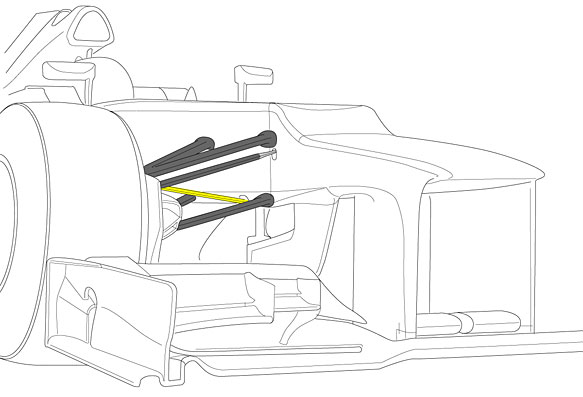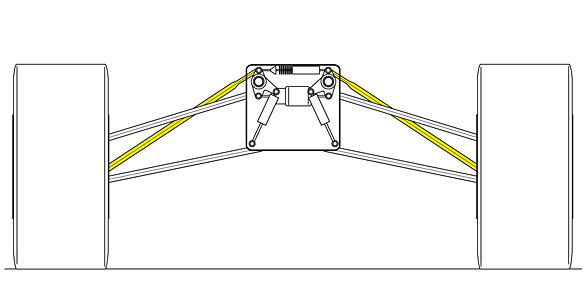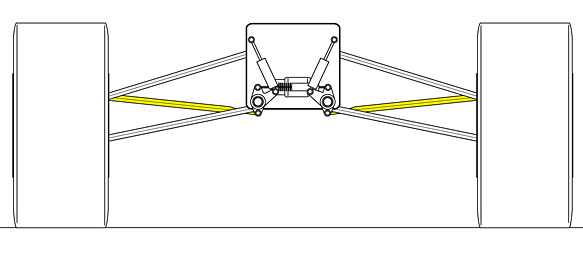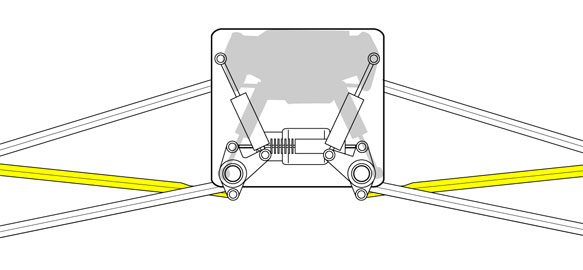The pros and cons of Ferrari's pull-rod design
With Ferrari having opted for a pull-rod suspension for the front end of its F2012, the layout returns to F1 after an absence of 10 years. Craig Scarborough looks at the pros and cons of the design.
By Craig Scarborough
AUTOSPORT contributing writer
It's often said there is nothing new in F1 in terms of design. Instead, there's a revolving cycle, with ideas being dropped and readopted over the years.
Ferrari's launch of its radical F2012 brought the return of pull-rod suspension to the front end of the car, an idea thought impractical with the current high noses. But with pull-rod suspension at the rear of the car also being in vogue, how does this design differ from the more established push-rod and what are the technical benefits?
<table style="margin-left: 0px; margin-right: 0px;" class="pictable" width="583" align="center" border="0" cellpadding="0" cellspacing="0"> <tbody> <tr> <td> The suspension is highlighted grey and the near horizontal pull-rod in yellow
The suspension is highlighted grey and the near horizontal pull-rod in yellow
</td></tr></tbody></table>
A push\pull-rod is the means by which the wheel movement is transferred to the spring\dampers, as well as the antiroll and heave mechanisms forming part of the modern F1 suspension system. The rod mounted to the wishbone rotates a rocker to which all of these mechanisms are then attached.
In the case of the Ferrari F2012, the pull-rod mounts to the top wishbone and then passes nearly horizontally across to the lower edge of the chassis. This is an inverted version of a push-rod, which has the push-rod mounted to the lower wishbone and passes up at a steep angle to the top edge of the chassis. Pull-rod suspension was last seen on the front of the car in 2001 with the Minardi PS01. There hasn't been a car with pull-rod both ends for well over ten years.
Background
<table style="margin-left: 0px; margin-right: 0px;" class="pictable" width="583" align="center" border="0" cellpadding="0" cellspacing="0"> <tbody> <tr> <td> This is an example of a push-rod set-up. Note the steeply angled push-rod (yellow)</td></tr></tbody></table>
This is an example of a push-rod set-up. Note the steeply angled push-rod (yellow)</td></tr></tbody></table>
In the late seventies, Gordon Murray adopted pull-rod suspension for the Brabhams he designed. This had the benefit of being very slim aerodynamically, as the rod was so thin and the larger rocker and spring/damper were mounted inside the chassis. During the early eighties most teams adopted pull-rod suspension. When ground effect was banned for the 1983 season, Murray innovated again by turning the pull-rod upside down and created the push-rod. Instead of the rod pulling the rocker, the rod now pushed the rocker, which in turn was now mounted at the top of the chassis.
Over the following 30 years, car design evolved to converge towards the push-rod design. That was until 2009, when Adrian Newey had the pull-rod reborn, with it being fitted to the rear of the Red Bull RB5. All teams have since followed this solution, but retained push-rod at the front.
<table style="margin-left: 0px; margin-right: 0px;" class="pictable" width="583" align="center" border="0" cellpadding="0" cellspacing="0"> <tbody> <tr> <td> This is an example of a pull-rod set-up. Note the near horizontal pull-rod (yellow)
This is an example of a pull-rod set-up. Note the near horizontal pull-rod (yellow)
</td></tr></tbody></table>
Ferrari front pull-rod
When the rumour of front pull-rod was circulated during the pre-season, it didn't seem realistic that this could work. At the rear the low position of the gearbox makes the pull-rod geometry easy to achieve, but at the front the chassis is some 30cm in the air; this places the pull-rod nearly horizontally.
Intuitively, this looks like the rod would barely move the rocker as the wheel rises. But the pull-rod actually operates by creating a triangle with the wishbone, so in actual fact it's the angle between the wishbone and pull-rod that creates the displacement. When comparing Ferrari's pull-rod geometry to a push-rod, the relative angles are the same and therefore both operate the rocker equally efficiently.
So clearly Ferrari has found a solution that has similar geometry to the push-rod that went before it. So it's unlikely that they have gone this route for improvement in operating suspension. he most likely benefit will be aerodynamics and packaging.
Aerodynamics may seem an odd benefit; it's true the pull-rod can be thinner, which might create a small benefit, but it's likely the near horizontal position of the pull-rod is the key to the real benefit. Teams already shape their wishbones to manage airflow off the front wing. Within the tight rules, quite a lot of aero effect is achieved with the wishbones. As the pull-rod is horizontal compared to the angled push-rod, it can be more effective in altering the airflow over the car.
<table style="margin-left: 0px; margin-right: 0px;" class="pictable" width="583" align="center" border="0" cellpadding="0" cellspacing="0"> <tbody> <tr> <td> With a pull-rod the spring and dampers are mounted much lower than with a push-rod (shaded) to lower the centre of gravity
With a pull-rod the spring and dampers are mounted much lower than with a push-rod (shaded) to lower the centre of gravity
</td></tr></tbody></table>
Also the packaging around the front brake ducts becomes easier compared to push-rod, as a pull-rod no longer passes straight through the area where the cooling scoop is fitted. This creates more freedom for the designer to shape the brake ducts.
With the F2012's nose and chassis being raised to their maximum, the centre of gravity of the car will be also be raised. As pull-rod effectively turns the push-rod system upside down, the weight of the rockers, torsion bars and other mechanical parts are now placed at the bottom of the nose, rather than the top. This helps lower the centre of gravity a little, to offset the new nose design.
However, no gains come without compromises. Having the pull-rod mounted to the top wishbone creates much greater loads in the wishbone. This means the wishbone and its mounting with the chassis need to be stronger, this will cost some weight.
Ferrari appeared to have struggled in the first test. With so many new solutions on the car it's hard to pinpoint what might be causing the issues. Going its own direction with pull-rod suspension at the front might be seen a risk this year, but with suspension simulation on both computer software and on the seven-post rig, it's unlikely the pull-rod set-up will be contributing to the problems.
Overall, the gains for a pull-rod set-up are small, but clearly worth chasing. Ferrari has stolen a march on its competitors with the front pull-rod. Its rivals will not be able to react to the change this year, due to a completely now monocoque and front suspension being needed. For such a small gain, this would be a time consuming and expensive change mid-season. Now doubt this concept will go onto the "to do" list of the design teams for their 2013 cars.